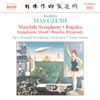Mayuzumi Orchestral Works
Delicate, graceful music from Japan reveals much about its composer
View record and artist detailsRecord and Artist Details
Composer or Director: Toshiro Mayuzumi
Genre:
Orchestral
Label: Naxos
Magazine Review Date: 3/2006
Media Format: CD or Download
Media Runtime: 68
Mastering:
Stereo
DDD
Catalogue Number: 8 557693

Tracks:
| Composition | Artist Credit |
|---|---|
| Symphonic Mood |
Toshiro Mayuzumi, Composer
New Zealand Symphony Orchestra Takuo Yuasa, Conductor Toshiro Mayuzumi, Composer |
| Bugaku |
Toshiro Mayuzumi, Composer
New Zealand Symphony Orchestra Takuo Yuasa, Conductor Toshiro Mayuzumi, Composer |
| Mandala Symphony |
Toshiro Mayuzumi, Composer
New Zealand Symphony Orchestra Takuo Yuasa, Conductor Toshiro Mayuzumi, Composer |
| Rumba Rhapsody |
Toshiro Mayuzumi, Composer
New Zealand Symphony Orchestra Takuo Yuasa, Conductor Toshiro Mayuzumi, Composer |
Author: K Smith
Unlike many post-war Japanese composers, whose programme-notes were filled with Asian references but whose works sounded generically Euro-modernist, Yokohama-born Toshiro Mayuzumi was no mere mimic of the West. Something of a Hollywood celebrity after scoring the 1966 film The Bible (when director John Huston touted him as ‘a modern Beethoven’), Mayuzumi’s biggest musical breakthrough had come years before with his Nirvana Symphony (1958), a piece that memorably drew inspiration from Buddhist chant and temple-bells, and ended up sounding undeniably Japanese.
These pieces reveal that, however much his musical ideas progressed over time, his general conception of the orchestra had always been in place. Despite a rather anaemic Rumba Rhapsody (1948), an early symphonic sketch recalling wartime Japanese pop-music fashions, Mayuzumi summons a significantly more profound nostalgia in his Symphonic Mood (1950), a vaguely French musical platform connecting those Latin elements with sounds of south-east Asia.
The Mandala Symphony (1960), on the other hand, picks up from Nirvana, again taking a page from Varèse and Messiaen in using sounds not only for exoticism but also formal structure, with temple-bell overtones determining two contrasting tone-rows to paint a portrait of enlightenment. In Bugaku (1962), a dance piece for the New York City Ballet, he is less ethereal and more grounded, depicting the microtonal slides characteristic of gagaku, the ancient court music.
Under Takuo Yuasa, the New Zealand Symphony Orchestra manage a delicate balance of surface and form, gracefully revealing how Mayuzumi borrowed from Western models only what he needed to best express his point. It’s the key not only to the composer’s musical process but also to his entire way of life.
These pieces reveal that, however much his musical ideas progressed over time, his general conception of the orchestra had always been in place. Despite a rather anaemic Rumba Rhapsody (1948), an early symphonic sketch recalling wartime Japanese pop-music fashions, Mayuzumi summons a significantly more profound nostalgia in his Symphonic Mood (1950), a vaguely French musical platform connecting those Latin elements with sounds of south-east Asia.
The Mandala Symphony (1960), on the other hand, picks up from Nirvana, again taking a page from Varèse and Messiaen in using sounds not only for exoticism but also formal structure, with temple-bell overtones determining two contrasting tone-rows to paint a portrait of enlightenment. In Bugaku (1962), a dance piece for the New York City Ballet, he is less ethereal and more grounded, depicting the microtonal slides characteristic of gagaku, the ancient court music.
Under Takuo Yuasa, the New Zealand Symphony Orchestra manage a delicate balance of surface and form, gracefully revealing how Mayuzumi borrowed from Western models only what he needed to best express his point. It’s the key not only to the composer’s musical process but also to his entire way of life.
Discover the world's largest classical music catalogue with Presto Music.

Gramophone Digital Club
- Digital Edition
- Digital Archive
- Reviews Database
- Full website access
From £8.75 / month
Subscribe
Gramophone Full Club
- Print Edition
- Digital Edition
- Digital Archive
- Reviews Database
- Full website access
From £11.00 / month
Subscribe
If you are a library, university or other organisation that would be interested in an institutional subscription to Gramophone please click here for further information.




